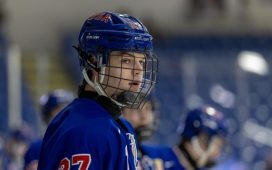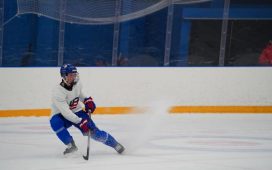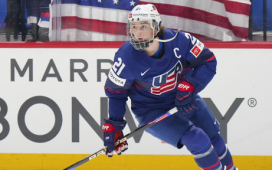Achieving four more years of labor peace in a middle of a pandemic that has halted hockey for four months? It’s a pretty good look. The NHL and NHL Players’ Association announced Monday they’d reached a tentative agreement on a collective bargaining agreement extension through 2025-26. As part of the agreement, some key return-to-play dates have been established. Training camps will formally open to launch Phase 3 July 13. Teams will travel to the (unofficially announced) hub cities, Edmonton and Toronto, July 26. The qualifying round of the 24-team play-in tournament will commence Aug. 1.
As for the Phase 3 and 4 safety protocol, the NHL and NHLPA released two documents, totalling 48 pages, outlining each.
Click here for the full Phase 3 document.
Click here for the full Phase 4 document.
Are you a “Too Long, Didn’t Read” type? Here’s a quick look at some key takeaways for each phase.
PHASE 3: Training camp
1. Full steam ahead on team activities. During Phase 2, workouts were voluntary and consisted of activities in smaller group training sessions. For Phase 3, teams can operate the equivalent of real NHL training camps, with “full team activities on and off the ice.” Players, coaches and hockey operations staff can have direct interactions as they would during any normal season. Up to 30 playoff-eligible skaters will be allowed to participate, plus an unlimited number of goalies.
2. Players can still opt out of the season. Players can opt out without discipline or penalty if they notify their teams within 72 hours of the CBA’s ratification.
3. Social distancing is still in effect off the ice. Players are allowed to engage in full contact during drills that require it but must remain six feet apart from each other during any other interactions in team facilities and are discouraged from having social contact away from club facilities. When players are not exercising, “Face coverings (cloth or surgical-type mask) shall be worn when entering or leaving the Club facility and, while inside the Club facility, and where social distancing cannot be maintained, such as in one on one sessions with an athletic trainer or massage therapist.”
4. Families are allowed. Players who don’t have permanent residences in their teams’ cities will be provided with separate hotel accommodations – including family-friendly accommodations for those bringing their families along.
5. COVID-19 testing before and after returning to team facilities. Anyone returning to club team facilities for training camp will be tested 48 hours prior and every other day after that. Per the Phase-3 document, “In order to detect active or recent infection, laboratory-based RT-PCR testing shall be administered to: (i) all Players; (ii) all Club personnel designated to have “Player Access”; and (iii) ice maintenance personnel, building maintenance, and security personnel who will be in the vicinity of Players while working.” Players and personnel will also conduct daily symptom and temperature checks within two hours of heading to club facilities and will be tested again by their teams before entering the facilities.
If a player or club staffer tests positive: Anyone who shows COVID-19 symptoms or comes in close contact with someone who has tested positive must immediately notify team medical staff and self isolate. If that person tests positive, they can only return to team facilities once they test negative twice, 24 hours apart, following the resolution of fever and improvement of respiratory symptoms. Per the document, “The individual can also return to team facilities after a minimum of 10 days in self-isolation following the onset of symptoms if they have had no fever or respiratory symptoms for more than 72 hours.”
PHASE 4: The 24-team tournament
1. Each of the teams in the two hub cities will be stationed in ‘Secure Zones.’ Per the NHL’s Phase 4 document, the Secure Zones will consist of “hotel(s), dining destinations, the arena, the practice facility(ies), and other demarcated areas (indoor and outdoor). Anyone not working or staying within a Secure Zone will not be permitted to enter.
2. 52 people per team, including on- and off-ice members. Rosters will be capped at 31 players including goalies. In total, including ownership, executives, coaches, hockey operations and training staff, each team can bring a maximum of 52 people inside the Secure Zones. With 12 teams playing in each hub city, that’s 624 team members per city.
3. Certain people will be allowed to come and go from the Secure Zones under specific conditions. People coming and going from the Secure Zones, such as arena and hotel personnel, will have to undergo daily testing and wear protective facial covering inside and outside the Secure Zones. They will also be required to refrain from activities in groups of 10 or more people. NHL team members will only be allowed to leave the Secure Zone for specific exceptions such as medical consultations or family emergencies. Upon return, they’ll need at least four consecutive negative COVID-19 PCR tests over a four-day period and will have to quarantine in their individual hotel rooms until that happens. Anyone who leaves the Secure Zone without permission will face consequences ranging from 14-day quarantine to being dismissed outright from participating in Phase 4.
4. Families are allowed – but not until the conference finals. Family members won’t be allowed in the Secure Zones for the qualifying round, round-robin, Round of 16 or Round of 8, but players will be allowed to invite immediate family members to stay with them during the conference finals and Stanley Cup final. No guests will be allowed inside the Secure Zones for all of Phase 4.
5. A variety of COVID-19 tests before and after entering the Secure Zones. In the seven days before teams’ charter flights to the hub cities, each person will take three tests, 48 hours apart. Once established in the Secure Zones, everyone will take daily tests, including symptom checks and temperature checks.
If a player or club staffer tests positive: The protocol will be similar to Phase 3’s. In the event of a positive player test during Phase 3 or 4, teams cannot share the information with the media or the public unless the league and the PA approve.
Want more in-depth features, analysis and an All-Access pass to the latest content? Subscribe to The Hockey News magazine.








